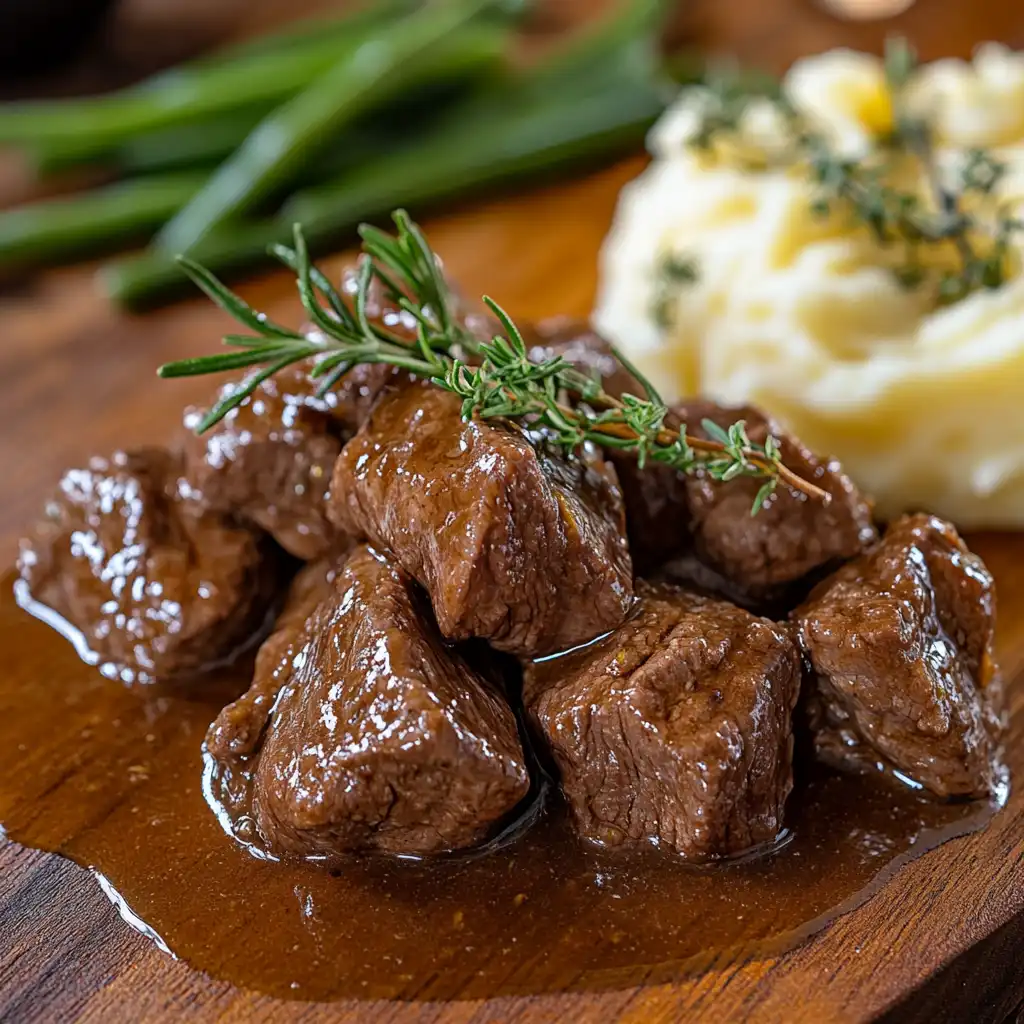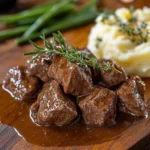
Beef tips are a versatile and flavorful ingredient commonly used in a variety of dishes. Their rich taste and tender texture make them a favorite for hearty meals. In this guide, we’ll explore what beef tips are, the cuts they come from, and their popular uses in cooking.
Table of Contents
What Are Beef Tips?
Beef tips are small pieces of beef cut from tender sections of the animal. They are often derived from the ends of larger cuts, such as sirloin or tenderloin, but can also come from more affordable cuts like chuck or round. These pieces are typically trimmed of excess fat and gristle, making them ready for use in stews, stir-fries, and other dishes.
Common characteristics of beef tips include:
- Flavorful: Known for their rich, beefy taste, which enhances the depth of many recipes.
- Tender: When prepared properly, they become tender and juicy, making them ideal for slow cooking or quick sautéing.
- Versatile: Suitable for a range of cooking techniques and cuisines.
Cuts Used for Beef Tips
The term “beef tips” doesn’t refer to a specific cut but rather small pieces trimmed from various sections of beef. Here are the most common sources of beef tips:
- Sirloin: These tips are among the most tender and flavorful, perfect for dishes where tenderness is a priority.
- Tenderloin: Extremely tender, though often more expensive, tenderloin tips are ideal for premium recipes.
- Chuck: A budget-friendly option, these tips are slightly tougher but become tender when slow-cooked.
- Round: Leaner and less expensive, round tips work well in recipes that involve marination or slow cooking to enhance tenderness.
Common Dishes Made with Beef Tips
Beef tips are a staple in many kitchens due to their adaptability. Here are some popular dishes where beef tips shine:
- Beef Stroganoff: A creamy, comforting dish with beef tips, mushrooms, and a tangy sour cream sauce.
- Stews and Braises: Beef tips absorb the flavors of broths and vegetables when slow-cooked, creating a hearty meal.
- Beef Tips with Gravy: Served over rice, mashed potatoes, or noodles, this classic dish is rich and satisfying.
- Stir-Fries: Their quick cooking time makes beef tips an excellent choice for stir-fried dishes with vegetables and sauces.
- Kabobs: Marinated beef tips grilled on skewers with vegetables are a summer favorite.
- Beef and Vegetable Soup: A wholesome soup featuring tender beef tips and a mix of fresh vegetables.
By understanding the cuts and uses of beef tips, you can elevate your cooking with this versatile ingredient. Whether preparing a quick stir-fry or a slow-simmered stew, beef tips are a reliable choice for delicious, hearty meals.
The Science Behind Meat Tenderness
Understanding the factors that influence meat tenderness is key to preparing delicious beef dishes. From biological and chemical properties to cooking techniques, several elements determine how tender a piece of meat will be.
What Makes Meat Tender?
Meat tenderness is influenced by a combination of biological and chemical factors:
- Muscle Composition: The type of muscle impacts tenderness. Muscles that do less work, like those in the loin, are naturally more tender than those used for heavy lifting, such as the shoulder.
- Marbling: Intramuscular fat, or marbling, contributes to tenderness by providing moisture and flavor during cooking.
- Age of the Animal: Younger animals tend to have more tender meat due to less-developed connective tissues.
- Enzymes: Natural enzymes in meat, like calpains, break down proteins after slaughter, tenderizing the meat over time.
- Post-Mortem Aging: Allowing meat to age under controlled conditions improves tenderness by breaking down muscle fibers and connective tissues.
The Role of Collagen in Beef Tips
Collagen, a key connective tissue in meat, significantly affects tenderness. Its behavior during cooking depends on the method and duration:
- Collagen Structure: In raw meat, collagen is tough and fibrous. However, it gradually breaks down into gelatin when exposed to moist heat.
- Slow Cooking: Prolonged low heat transforms collagen into gelatin, resulting in tender, flavorful beef tips.
- High Heat Cooking: Quick, high-heat methods don’t give collagen enough time to break down, often leading to tougher meat.
Heat and Muscle Fibers: A Delicate Balance
Muscle fibers are sensitive to temperature, and how you cook beef tips can make or break their tenderness:
- Protein Denaturation: As heat is applied, muscle proteins denature, or change shape, causing the meat to firm up.
- Moisture Loss: Overcooking forces moisture out of muscle fibers, leading to dry and chewy meat.
- Optimal Temperature: Maintaining the right temperature and cooking time is crucial to preserving tenderness and juiciness.
Cooking Methods for Beef Tips
Choosing the right cooking method for beef tips can greatly influence their tenderness and overall quality. Each method has its strengths and challenges.
Slow Cooking: Pros and Cons

Slow cooking is a popular method for beef tips, particularly for tough cuts.
Pros:
- Breaks down collagen into gelatin, resulting in tender meat.
- Allows flavors to meld, enhancing the overall dish.
- Requires minimal attention once started.
Cons:
- Time-intensive, often taking several hours.
- Can lead to overcooking if not monitored properly.
Pressure Cooking: Quick Tenderness
Pressure cooking is an efficient way to tenderize beef tips.
Pros:
- Rapid cooking process, ideal for busy schedules.
- Breaks down collagen quickly, producing tender results in a fraction of the time.
Cons:
- Can be difficult to control the final texture.
- Requires a learning curve to avoid overcooking.
Grilling and Pan-Searing: Tenderness Challenges
Grilling and pan-searing are high-heat methods that enhance flavor but pose challenges to tenderness.
Pros:
- Creates a flavorful crust through the Maillard reaction.
- Ideal for quick cooking of tender cuts like sirloin tips.
Cons:
- High heat can toughen meat if overcooked.
- Doesn’t break down collagen, making it less suitable for tougher cuts.
By understanding the science of tenderness and selecting the right cooking method, you can elevate the quality of your beef tips, ensuring every dish is flavorful and enjoyable.
The Role of Time in Tenderness
Cooking time plays a critical role in determining the tenderness and flavor of beef tips. While longer cooking times can help tenderize tougher cuts, there’s a balance to be struck—too much time can lead to undesirable results.
How Long Is Too Long?
Overcooking meat can negatively impact both its tenderness and flavor, even when slow-cooking. Key considerations include:
- Moisture Loss: Excessively long cooking times can cause the meat to lose too much moisture, leaving it dry and stringy despite the breakdown of connective tissues.
- Texture Issues: While collagen transforms into gelatin with time, the muscle fibers themselves may continue to contract and toughen, leading to a mushy or rubbery texture.
- Flavor Dilution: Overcooking can result in a loss of the beef’s natural flavors, leaving the dish overly reliant on seasonings or sauces to compensate.
For most recipes, finding the optimal cooking time is essential to maintaining both tenderness and flavor.
Low and Slow: The Sweet Spot
The “low and slow” cooking method is widely regarded as the best way to achieve perfectly tender beef tips. Here’s why:
- Collagen Breakdown: Cooking at low temperatures for an extended period allows collagen to break down gently into gelatin, which keeps the meat moist and tender.
- Flavor Development: Slow cooking gives the meat and other ingredients time to meld, resulting in a richer, more complex flavor profile.
- Temperature Control: Low heat minimizes the risk of overcooking and ensures even cooking throughout the meat.
Best Practices for Low and Slow Cooking:
- Use the Right Cut: Tougher cuts like chuck or round respond well to this method due to their higher collagen content.
- Monitor Liquid Levels: Ensure there’s enough liquid to prevent the meat from drying out and to create a flavorful sauce or broth.
- Optimal Cooking Time: Depending on the recipe and cut, beef tips generally require 6–8 hours in a slow cooker on low heat or 2–3 hours on the stovetop at a gentle simmer.
By understanding the delicate balance of cooking time, you can achieve tender, flavorful beef tips that delight every palate. Low and slow cooking remains the go-to method for transforming tough cuts into melt-in-your-mouth dishes while preserving their natural richness.
Marinating Beef Tips for Tenderness
Marinating is a tried-and-true method for enhancing the tenderness and flavor of beef tips. By using the right ingredients, marinades can break down tough fibers and infuse the meat with rich, complementary flavors.
Best Marinades for Beef Tips
The best marinades balance flavor-enhancing ingredients with tenderizing components. Here are some popular marinades and their key ingredients:
1. Classic Soy-Garlic Marinade
- Ingredients: Soy sauce, garlic, brown sugar, sesame oil, and ginger.
- Benefits: Soy sauce adds umami and salt, which helps tenderize and season the meat, while garlic and ginger provide depth of flavor.
2. Citrus-Herb Marinade
- Ingredients: Lemon juice, olive oil, rosemary, thyme, and black pepper.
- Benefits: The acidity of the lemon juice breaks down muscle fibers, and the herbs add a fresh, aromatic profile.
3. Red Wine and Herb Marinade
- Ingredients: Red wine, olive oil, minced garlic, oregano, and bay leaves.
- Benefits: Red wine’s acidity tenderizes the meat, while its tannins and herbs impart a robust, savory flavor.
4. Buttermilk or Yogurt Marinade
- Ingredients: Buttermilk or plain yogurt, garlic, paprika, and cumin.
- Benefits: The lactic acid in buttermilk or yogurt gently tenderizes the beef while adding a creamy texture and tangy flavor.
5. Pineapple or Papaya Marinade
- Ingredients: Pineapple juice or papaya puree, soy sauce, and honey.
- Benefits: The enzymes in pineapple (bromelain) and papaya (papain) are natural meat tenderizers that work quickly.
Acidic vs. Enzymatic Marinades
Different types of marinades work in unique ways to tenderize beef tips. Here’s a comparison of their effects:
Acidic Marinades
- How They Work: Acids like vinegar, citrus juice, or wine break down the surface proteins of the meat, leading to increased tenderness.
- Advantages:
- Easy to make with common pantry ingredients.
- Great for slow-absorbing, deep flavor development.
- Limitations:
- Over-marinating can make the meat mushy or overly tangy.
- Works best when the marinade time is carefully controlled (usually 4–6 hours).
Enzymatic Marinades
- How They Work: Enzymes from fruits like pineapple, papaya, or kiwi actively break down proteins, tenderizing the meat.
- Advantages:
- Works quickly (in as little as 30 minutes to 2 hours).
- Ideal for tougher cuts like chuck or round.
- Limitations:
- Overuse can turn the meat overly soft or mushy.
- Not suitable for long marination periods.
Tips for Effective Marinating
- Time It Right: Marinate for at least 2–6 hours but no longer than 24 hours to avoid over-tenderizing.
- Choose the Right Container: Use a glass or plastic container to avoid chemical reactions with acidic ingredients.
- Even Coverage: Ensure the marinade fully coats the beef tips for consistent flavor and tenderness.
- Pat Dry Before Cooking: Remove excess marinade to promote browning and prevent steaming during cooking.
By selecting the right marinade and understanding how it works, you can transform beef tips into tender, flavorful bites, perfect for a wide range of dishes.
FAQs About Beef Tips and Cooking Time
Cooking beef tips can lead to many questions about achieving the perfect balance between tenderness and flavor. Here are answers to some of the most common inquiries.
Do Beef Tips Get More Tender the Longer They Cook?
Yes, but with limits.
Beef tips tend to become more tender the longer they are cooked, provided they are prepared with methods that maintain moisture, such as slow cooking or braising. The science behind this lies in the breakdown of collagen—a tough connective tissue that converts to gelatin when exposed to prolonged, low heat. However, overcooking can lead to dryness and a loss of flavor as the muscle fibers contract and expel moisture.
Key Takeaway:
Cook beef tips low and slow, and avoid excessively long cooking times to prevent drying out.
How Do You Know When Beef Tips Are Done?
Beef tips are done when they reach the desired tenderness and a safe internal temperature. Here’s how to check:
- Visual and Textural Cues: Beef tips should be fork-tender but not falling apart. Gently prod the meat with a fork; it should slide in with minimal resistance.
- Internal Temperature: Use a meat thermometer to ensure the meat reaches at least 145°F (63°C) for medium-rare or 160°F (71°C) for medium.
- Taste Test: A small bite is the ultimate test for tenderness and flavor.
What Is the Best Way to Cook Beef Tips?
The best method depends on the cut and your desired outcome:
- Slow Cooking/Braising: Ideal for tougher cuts like chuck or round, as it breaks down collagen into gelatin for rich, tender beef.
- Grilling/Pan-Searing: Best for tender cuts like sirloin tips, where high heat can create a flavorful crust while retaining moisture inside.
- Pressure Cooking: Perfect for quickly tenderizing tougher cuts without losing flavor, especially when time is limited.
Recommendation:
For most cuts, slow cooking with a flavorful broth or sauce is the most foolproof way to ensure tender and delicious beef tips.
Enhancing Flavor While Maintaining Tenderness
Adding flavor to beef tips without compromising their tenderness requires careful use of seasonings, broths, and cooking techniques.
Using Herbs, Spices, and Broths
- Herbs and Spices: Rosemary, thyme, bay leaves, and black pepper are classic additions that enhance beef’s natural flavor.
- Broths and Stocks: Cooking beef tips in beef or vegetable broth infuses them with moisture and rich flavor. Adding wine or soy sauce can deepen the taste profile.
- Aromatics: Garlic, onions, and shallots release bold flavors as they cook alongside the beef.
Pro Tip:
Layer flavors by seasoning the beef before cooking, adding herbs and spices during cooking, and finishing with fresh herbs for a burst of aroma.
Deglazing and Sauces for Beef Tips
Deglazing is a technique that enhances flavor by using the browned bits left in the pan (fond) after searing beef tips. Here’s how:
- Deglaze the Pan: Add liquid (wine, broth, or water) to the hot pan and scrape the fond with a wooden spoon.
- Create a Sauce: Simmer the deglazing liquid with butter, cream, or additional spices to make a complementary sauce.
Popular Sauce Options:
- Mushroom Gravy: Made with sautéed mushrooms, broth, and cream for a rich, earthy flavor.
- Red Wine Reduction: A blend of red wine, broth, and aromatics for a sophisticated taste.
- Peppercorn Sauce: Crushed peppercorns simmered with cream and stock for a spicy kick.
By combining herbs, broths, and sauces with thoughtful cooking techniques, you can elevate the flavor of beef tips while keeping them tender and juicy.
1. The Role of Collagen in Tenderness
Collagen, a connective tissue, breaks down into gelatin during prolonged, low-temperature cooking, making tougher cuts tender. For more insights into preparing beef tips perfectly, explore The Ultimate Guide to the Perfect Beef Tips Recipe.
2. Balancing Cooking Time
While longer cooking helps soften connective tissue, overcooking can cause muscle fibers to contract excessively, leading to dryness. If you’re comparing beef tips with other cuts, check out Stew Meat vs. Beef Tips: Differences, Uses, and Best Recipes.
3. Best Cooking Methods
Slow cooking or braising is ideal for achieving tender beef tips, especially for tougher cuts like chuck. For recipes and techniques that maximize flavor and tenderness, visit The Ultimate Guide to the Perfect Beef Tips Recipe.
Conclusion
Yes, beef tips do get more tender the longer they cook, but only up to a point. Understanding the science behind collagen breakdown and using the right cooking techniques are key to achieving perfectly tender results. For more tips and tricks, don’t miss our comprehensive resources like The Ultimate Guide to the Perfect Beef Tips Recipe.
Final Thoughts: Perfectly Tender Beef Tips
Achieving perfectly tender beef tips requires a thoughtful approach:
- Understand Your Cut: Select the right cut for your cooking method—tougher cuts like chuck or round benefit from slow cooking, while tender cuts like sirloin can be quickly grilled or pan-seared.
- Master the Cooking Time: Opt for “low and slow” methods for breaking down collagen or use pressure cooking for fast results, avoiding overcooking to preserve moisture and flavor.
- Marinate for Success: Use acidic or enzymatic marinades to tenderize and infuse the beef with flavor.
- Enhance with Flavorful Additions: Incorporate broths, herbs, spices, and deglazing techniques to create complex, satisfying dishes.
By combining these techniques, you can consistently prepare beef tips that are tender, flavorful, and a delight to serve. Whether in a hearty stew, a savory stir-fry, or a comforting gravy, your beef tips will be the star of any meal.
Slow-Cooked Beef Tips
Equipment
- Slow Cooker
Ingredients
Beef Tips
- 2 pounds beef tips cut from chuck or round
- 1 cup beef broth
- 2 tablespoons soy sauce
- 1 teaspoon garlic powder
- 1 teaspoon onion powder
- 1 bay leaf bay leaf
- 1 cup mushrooms sliced
- 2 carrots carrots sliced
- 1 onion onion chopped
Instructions
- Marinate the beef tips in soy sauce, garlic powder, and onion powder for at least 10 minutes.
- In a slow cooker, combine the marinated beef tips, beef broth, bay leaf, mushrooms, carrots, and onion.
- Cover and cook on low heat for 5-6 hours, or until the beef tips are tender and juicy.
- Serve hot over mashed potatoes or rice, garnished with fresh herbs if desired.

